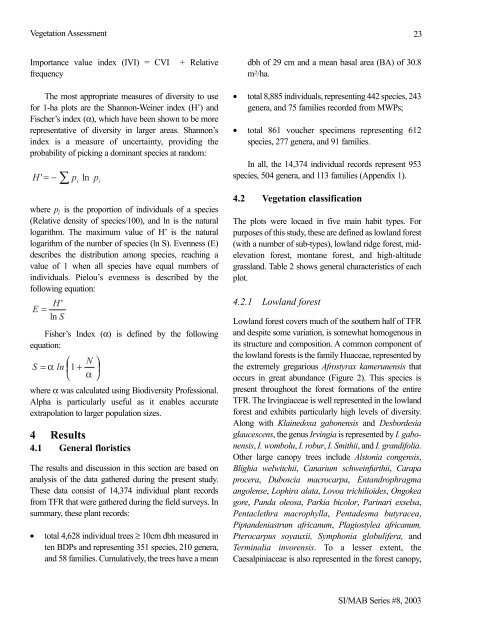Fisheries in the Southern Border Zone of Takamanda - Impact ...
Fisheries in the Southern Border Zone of Takamanda - Impact ...
Fisheries in the Southern Border Zone of Takamanda - Impact ...
Create successful ePaper yourself
Turn your PDF publications into a flip-book with our unique Google optimized e-Paper software.
Vegetation Assessment<br />
Importance value <strong>in</strong>dex (IVI) = CVI + Relative<br />
frequency<br />
The most appropriate measures <strong>of</strong> diversity to use<br />
for 1-ha plots are <strong>the</strong> Shannon-We<strong>in</strong>er <strong>in</strong>dex (H’) and<br />
Fischer’s <strong>in</strong>dex (α), which have been shown to be more<br />
representative <strong>of</strong> diversity <strong>in</strong> larger areas. Shannon’s<br />
<strong>in</strong>dex is a measure <strong>of</strong> uncerta<strong>in</strong>ty, provid<strong>in</strong>g <strong>the</strong><br />
probability <strong>of</strong> pick<strong>in</strong>g a dom<strong>in</strong>ant species at random:<br />
∑<br />
H ©<br />
= − pi<br />
ln pi<br />
where p i is <strong>the</strong> proportion <strong>of</strong> <strong>in</strong>dividuals <strong>of</strong> a species<br />
(Relative density <strong>of</strong> species/100), and ln is <strong>the</strong> natural<br />
logarithm. The maximum value <strong>of</strong> H’ is <strong>the</strong> natural<br />
logarithm <strong>of</strong> <strong>the</strong> number <strong>of</strong> species (ln S). Evenness (E)<br />
describes <strong>the</strong> distribution among species, reach<strong>in</strong>g a<br />
value <strong>of</strong> 1 when all species have equal numbers <strong>of</strong><br />
<strong>in</strong>dividuals. Pielou’s evenness is described by <strong>the</strong><br />
follow<strong>in</strong>g equation:<br />
H ©<br />
E =<br />
ln S<br />
Fisher’s Index (α) is def<strong>in</strong>ed by <strong>the</strong> follow<strong>in</strong>g<br />
equation:<br />
⎛ N<br />
S = α ln ⎜1 +<br />
⎝ α<br />
⎞<br />
⎟<br />
⎠<br />
where α was calculated us<strong>in</strong>g Biodiversity Pr<strong>of</strong>essional.<br />
Alpha is particularly useful as it enables accurate<br />
extrapolation to larger population sizes.<br />
4 Results<br />
4.1 General floristics<br />
The results and discussion <strong>in</strong> this section are based on<br />
analysis <strong>of</strong> <strong>the</strong> data ga<strong>the</strong>red dur<strong>in</strong>g <strong>the</strong> present study.<br />
These data consist <strong>of</strong> 14,374 <strong>in</strong>dividual plant records<br />
from TFR that were ga<strong>the</strong>red dur<strong>in</strong>g <strong>the</strong> field surveys. In<br />
summary, <strong>the</strong>se plant records:<br />
• total 4,628 <strong>in</strong>dividual trees ≥ 10cm dbh measured <strong>in</strong><br />
ten BDPs and represent<strong>in</strong>g 351 species, 210 genera,<br />
and 58 families. Cumulatively, <strong>the</strong> trees have a mean<br />
dbh <strong>of</strong> 29 cm and a mean basal area (BA) <strong>of</strong> 30.8<br />
m 2 /ha.<br />
• total 8,885 <strong>in</strong>dividuals, represent<strong>in</strong>g 442 species, 243<br />
genera, and 75 families recorded from MWPs;<br />
• total 861 voucher specimens represent<strong>in</strong>g 612<br />
species, 277 genera, and 91 families.<br />
In all, <strong>the</strong> 14,374 <strong>in</strong>dividual records represent 953<br />
species, 504 genera, and 113 families (Appendix 1).<br />
4.2 Vegetation classification<br />
The plots were locaed <strong>in</strong> five ma<strong>in</strong> habit types. For<br />
purposes <strong>of</strong> this study, <strong>the</strong>se are def<strong>in</strong>ed as lowland forest<br />
(with a number <strong>of</strong> sub-types), lowland ridge forest, midelevation<br />
forest, montane forest, and high-altitude<br />
grassland. Table 2 shows general characteristics <strong>of</strong> each<br />
plot.<br />
4.2.1 Lowland forest<br />
Lowland forest covers much <strong>of</strong> <strong>the</strong> sou<strong>the</strong>rn half <strong>of</strong> TFR<br />
and despite some variation, is somewhat homogenous <strong>in</strong><br />
its structure and composition. A common component <strong>of</strong><br />
<strong>the</strong> lowland forests is <strong>the</strong> family Huaceae, represented by<br />
<strong>the</strong> extremely gregarious Afrostyrax kamerunensis that<br />
occurs <strong>in</strong> great abundance (Figure 2). This species is<br />
present throughout <strong>the</strong> forest formations <strong>of</strong> <strong>the</strong> entire<br />
TFR. The Irv<strong>in</strong>giaceae is well represented <strong>in</strong> <strong>the</strong> lowland<br />
forest and exhibits particularly high levels <strong>of</strong> diversity.<br />
Along with Kla<strong>in</strong>edoxa gabonensis and Desbordesia<br />
glaucescens, <strong>the</strong> genus Irv<strong>in</strong>gia is represented by I. gabonensis,<br />
I. wombolu, I. robur, I. Smithii, and I. grandifolia.<br />
O<strong>the</strong>r large canopy trees <strong>in</strong>clude Alstonia congensis,<br />
Blighia welwitchii, Canarium schwe<strong>in</strong>furthii, Carapa<br />
procera, Duboscia macrocarpa, Entandrophragma<br />
angolense, Lophira alata, Lovoa trichilioides, Ongokea<br />
gore, Panda oleosa, Parkia bicolor, Par<strong>in</strong>ari exselsa,<br />
Pentaclethra macrophylla, Pentadesma butyracea,<br />
Piptandeniastrum africanum, Plagiostylea africanum,<br />
Pterocarpus soyauxii, Symphonia globulifera, and<br />
Term<strong>in</strong>alia <strong>in</strong>vorensis. To a lesser extent, <strong>the</strong><br />
Caesalp<strong>in</strong>iaceae is also represented <strong>in</strong> <strong>the</strong> forest canopy,<br />
23<br />
SI/MAB Series #8, 2003

















